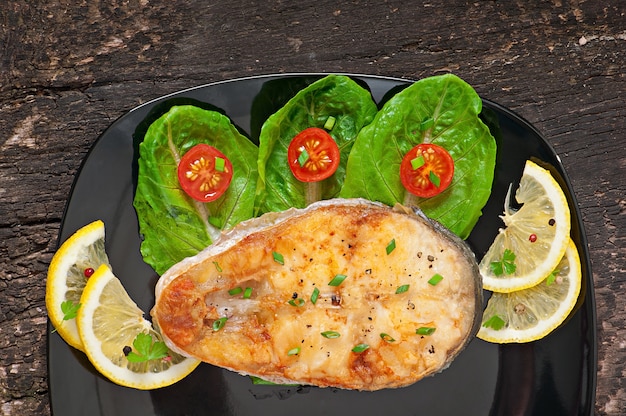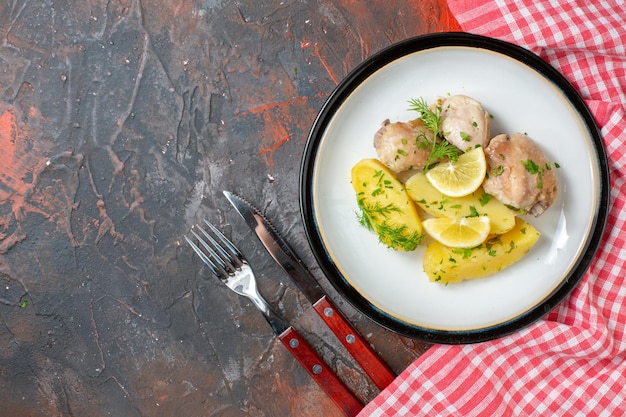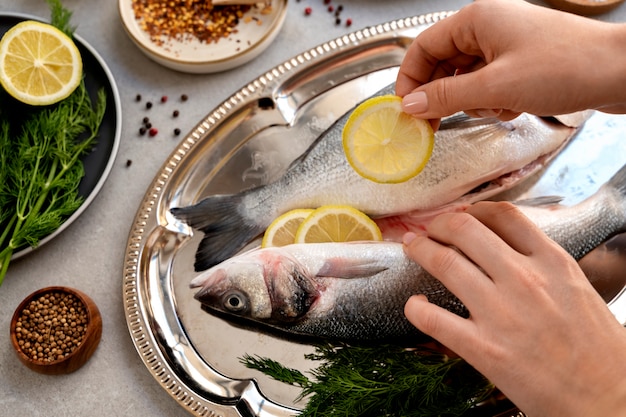Right, let's talk about haddock. It's a fish that's been a staple in British kitchens for centuries, and for good reason! It's incredibly versatile, packed with flavour, and a real bargain compared to some of its flashier fishy cousins. And best of all? It's pretty darn easy to cook. But before we get into all the delicious ways you can whip up this humble fish, let's take a quick dive into what makes haddock so special. I've been a bit of a haddock enthusiast for as long as I can remember. I grew up in a coastal town where it was practically the fish of choice for everything from Friday night fish and chips to a quick weeknight supper. My mum used to make this incredible haddock casserole that was basically comfort food in a dish, and it's still one of my all-time favourite meals. So, let's get started on this ultimate guide to haddock. I'm going to take you through all the different ways to cook it, from simple pan-fried fillets to more elaborate bakes and stews. We'll also cover how to pick the freshest haddock, how to store it, and even how to prepare it for cooking. Get ready for some serious haddock inspiration!
Part 1: Getting to Know the Fish

Haddock is a white fish, which means it has a mild, slightly sweet flavour and a firm, flaky texture. It's a great source of protein and omega-3 fatty acids, making it a healthy and delicious choice for any meal.
The Tale of Two Types:
Now, there are two main types of haddock you'll find in the shops. There's the traditional Scottish haddock, which has a slightly darker flesh and a stronger flavour. It's often caught in the North Sea and is prized for its rich, meaty texture. Then you've got Icelandic haddock, which is known for being a bit leaner and milder. It's sourced from the pristine waters around Iceland and tends to have a slightly more delicate flavour. Both types are absolutely delicious, and it really just comes down to personal preference. Personally, I'm a big fan of the Scottish haddock's strong flavour, but don't be afraid to experiment!
Sourcing Your Haddock
When choosing haddock, freshness is key. Look for fillets with firm, shiny skin and bright, clear eyes. The flesh should be pearly white and free of any unpleasant odours.
- Fishmonger's Choice: If you're lucky enough to have a good fishmonger nearby, they'll be your best bet for the freshest haddock. They'll know their fish inside out, and they'll be happy to give you advice on choosing the best cut for your recipe. They might even recommend a specific type of haddock, like a 'whole haddock' for baking or a 'fillet' for pan-frying.
- Supermarket Selection: If you're picking up haddock at the supermarket, look for fillets that are packaged in sealed, clear trays. These will help to keep the fish fresh for longer. Check the 'use by' date and make sure the packaging hasn't been damaged.
- Frozen Fish Files: Frozen haddock is a great option if you need to stock up or you're not planning on cooking it right away. Just make sure the packaging is intact and the fish hasn't been thawed and refrozen. Look for frozen haddock that has been flash-frozen for the best quality.
Part 2: The Art of Haddock Prep

Now that you've got your fresh haddock, it's time to prepare it for cooking. Don't worry, this part is super easy.
A Step-by-Step Guide:
- Rinse and Dry: Gently rinse the haddock under cold water to remove any dirt or debris. Pat it dry with paper towels. This will help to prevent the fish from sticking to the pan when cooking.
- Skin It (Optional): If you prefer to remove the skin, you can do this by gently lifting it with a sharp knife and pulling it back towards the tail. This is usually easier if you start at the tail end of the fillet. Removing the skin is a matter of preference, but it can be a bit easier to cook with skinless fillets.
- Boneless Beauty: If you're using fillets, they'll usually be boneless. However, if you're working with a whole haddock, it's a good idea to remove the bones. You can do this with a sharp knife, carefully slicing along either side of the backbone and removing it. This might take a little practice, but it's definitely doable.
- Cut to Size: Once you've prepped your haddock, cut it into portions or keep it whole, depending on your recipe. For pan-frying, you might want to cut the fillets into smaller pieces, while for baking, you'll want to leave the haddock whole.
Part 3: Pan-Fried Perfection

pan-fried haddock is a classic for a reason. It's quick, simple, and unbelievably delicious.
Ingredients:
- haddock fillets (about 2 per person)
- Olive oil (1-2 tablespoons)
- Salt and pepper (to taste)
- Lemon wedges (optional)
- Butter (optional, for added richness)
- Fresh herbs (parsley, dill, or chives, optional, for added flavour)
Method:
- Heat the Oil: Heat a tablespoon of olive oil in a non-stick frying pan over medium heat. You want the oil to be hot enough to sizzle when you add the fish, but not smoking hot.
- Season and Fry: Season the haddock fillets with salt and pepper. Place the fillets in the pan, making sure they don't overlap. Cook for about 3-4 minutes per side, or until golden brown and cooked through. You should be able to easily flake the fish with a fork.
- Serve it Up: Serve the pan-fried haddock immediately with lemon wedges, if desired. You can squeeze a little lemon juice over the fish for a zesty kick.
- Add Some Flair: For extra flavour, try adding a knob of butter to the pan towards the end of cooking. The butter will melt and coat the fish, adding richness and flavour. You can also sprinkle the fillets with herbs like parsley or dill just before serving.
Tips:
For extra crispy skin, try searing the fillets for a few minutes on each side before adding them to the pan. You can also add a splash of white wine to the pan towards the end of cooking for a more sophisticated flavour. If you're feeling adventurous, try adding a squeeze of lemon juice to the pan for a zesty kick. Don't overcook the fish! Haddock cooks quickly, so it's important to keep an eye on it.
Part 4: Bake It, Don't Break It
baked haddock is a fantastic way to cook a whole fish, and it's perfect for a family meal.
Ingredients:
- Whole haddock (about 1 per person)
- Olive oil (1 tablespoon)
- Salt and pepper (to taste)
- Fresh herbs (such as parsley, dill, or thyme)
- Lemon slices (2-3 slices)
- Butter (1-2 tablespoons, softened)
Method:
- Preheat and Prep: Preheat your oven to 375°F (190°C). Rinse the whole haddock and pat it dry.
- Season and Stuff: Rub the haddock inside and out with olive oil. Season with salt and pepper. Fill the cavity of the fish with fresh herbs and lemon slices.
- Bake It Good: Place the haddock on a baking sheet lined with parchment paper. Dot the fish with butter. Bake for 20-25 minutes, or until the flesh is opaque and flakes easily with a fork.
- Serving Suggestions: Serve the baked haddock with your favourite sides, such as roasted vegetables, mashed potatoes, or rice.
Tips:
For extra flavour, you can add a little white wine or lemon juice to the baking sheet before adding the fish. You can also wrap the haddock in foil to create a more moist environment while baking. If you're using a smaller haddock, reduce the baking time.
Part 5: Embrace the Stew
Haddock is absolutely perfect for making a comforting and flavourful stew.
Ingredients:
- Haddock fillets (about 1 lb)
- Vegetable stock (about 4 cups)
- Potatoes (2-3 medium, diced)
- Carrots (2-3 medium, diced)
- Onions (1 medium, chopped)
- Fresh herbs (such as parsley, dill, or thyme)
- Salt and pepper (to taste)
Method:
- Prepare the Vegetables: Peel and dice the potatoes, carrots, and onions.
- Sauté and Simmer: Heat some olive oil in a large pot or dutch oven over medium heat. Add the onions and sauté until softened. Add the carrots and potatoes and cook for a few minutes.
- Add the Fish and Stock: Pour in the vegetable stock, ensuring it covers the vegetables. Season with salt and pepper, and add your favourite herbs. Bring to a simmer, then add the haddock fillets.
- Cook and Serve: Simmer gently for about 10-15 minutes, or until the haddock is cooked through. Serve hot with a crusty bread for dipping.
Tips:
You can add other vegetables to the stew, such as leeks, celery, or peas. For a richer flavour, add a splash of cream or milk towards the end of cooking. You can also serve the haddock stew over rice or mashed potatoes.
Part 6: Beyond the Basics
Now that you've got the hang of the basic haddock recipes, let's get a little more adventurous.
Go Global:
Haddock can be incorporated into dishes from all over the world. Try a Moroccan tagine with haddock, olives, and spices, or a spicy Indian curry with coconut milk and haddock. For a lighter option, try a Greek-style baked haddock with tomatoes, oregano, and feta cheese. You can even explore Asian flavours with a haddock stir-fry featuring ginger, garlic, and soy sauce. The possibilities are endless!
Get Creative with Flavours:
- smoked haddock: Smoked haddock has a deeper, more complex flavour and is perfect for dishes like smoked haddock chowder or a creamy smoked haddock pasta sauce. The smokiness adds a dimension of flavour that's both rich and satisfying.
- Curried Haddock: Give your haddock a flavour punch with a curry sauce. You can make it mild or spicy, depending on your preference. Try using a combination of spices like turmeric, cumin, coriander, and garam masala for an authentic flavour.
- Lemon and Herb Haddock: A classic combination that's always a winner. Try adding chopped herbs like parsley, dill, and chives to your haddock before baking or grilling. You can also squeeze a little lemon juice over the fish for a zesty kick.
Part 7: Haddock Sides: Beyond the Basics
When it comes to sides for your haddock, think beyond the usual suspects like mashed potatoes and chips.
Healthy and Delicious:
- Roasted Vegetables: Roasted vegetables are a healthy and flavorful side for haddock. Try carrots, broccoli, asparagus, or peppers. Toss the vegetables with olive oil, salt, pepper, and your favourite herbs before roasting for a delicious and easy side.
- Green Salad: A simple green salad with a light vinaigrette dressing is a refreshing accompaniment to haddock. You can add some chopped nuts or seeds for extra texture and flavour.
- Quinoa or brown rice: These grains are packed with nutrients and make a healthy and hearty side for haddock. You can cook them with vegetable broth for extra flavour.
Comfort Food Classics:
- Mashed Potatoes: A classic comfort food side that's perfect for haddock. You can add a little butter, cream, and milk to your mashed potatoes for extra richness.
- Roasted Potatoes: Crisp and golden roasted potatoes are a delicious side for haddock. Try tossing them with olive oil, salt, pepper, and rosemary for a simple and flavourful side.
- Chips: For a real treat, serve your haddock with some crispy chips. You can make your own chips at home or pick up some freshly cooked chips from your local fish and chip shop.
Part 8: Haddock Storage
Keeping your haddock fresh is important.
Refrigerate with Care:
If you're not cooking your haddock immediately, store it in the refrigerator for up to 2 days. Wrap the fillets in cling film or store them in an airtight container. Keep the fish on the bottom shelf of your refrigerator, as this is the coldest part. This will help to prevent any cross-contamination from other foods.
Freeze with Confidence:
If you need to freeze your haddock, wrap the fillets in cling film and then place them in a freezer-safe bag. Frozen haddock will last for up to 3 months in the freezer. When freezing haddock, make sure to remove as much air from the bag as possible to prevent freezer burn.
Thaw with Time:
To thaw frozen haddock, transfer it from the freezer to the refrigerator and allow it to thaw overnight. Never thaw haddock at room temperature as this can encourage bacteria growth. If you need to thaw haddock quickly, you can do so in a bowl of cold water. Just make sure to change the water every 30 minutes to ensure that the haddock stays cold.
Part 9: Frequently Asked Questions
What are the best haddock recipes for beginners?
For beginners, I recommend starting with simple recipes like pan-fried haddock or baked haddock. These are both easy to make and very forgiving. You can also try making a basic haddock stew or a fish pie. These recipes are all easy to follow and require minimal ingredients and preparation.
How can I tell if haddock is cooked through?
The flesh should be opaque and flake easily with a fork. If you're unsure, insert a knife into the thickest part of the fillet. The fish should be cooked through if there's no pink left. Overcooked haddock will be dry and rubbery, so it's important to cook it to the right temperature.
What are some good wine pairings for haddock?
Haddock pairs well with crisp, white wines like Sauvignon Blanc, Pinot Grigio, or Vermentino. These wines have bright acidity that cuts through the richness of the fish. You can also try a light red wine, such as Pinot Noir. A good rule of thumb is to choose a wine that is lighter than the fish.
Can I use haddock for other recipes?
Absolutely! Haddock is incredibly versatile. You can use it in fish cakes, fish pies, or even in a fish curry. It's also a great ingredient for soups and stews. You can even try adding haddock to your favourite pasta dishes or salads. The possibilities are endless!
What are some healthy alternatives to frying haddock?
There are plenty of healthier alternatives to frying. Try baking, grilling, poaching, or steaming your haddock. These methods require less fat and can help to preserve the delicate flavour of the fish. Baking and grilling are great for adding a bit of char to the fish, while poaching and steaming will keep the fish moist and tender.
So there you have it - a comprehensive guide to cooking delicious haddock. From picking the freshest fish to experimenting with different flavours, you're now equipped to become a true haddock connoisseur. So get creative, experiment, and enjoy!
Happy haddock cooking!
Everyone is watching

Prime Rib Roast Cooking Time Chart: Per Pound Guide
Cooking TipsPrime rib roast. Just the name conjures images of lavish dinners, crackling fires, and hearty laughter. It’s ...

How Long to Bake Potatoes in the Oven (Perfect Every Time)
Cooking TipsBaked potatoes are a staple in my kitchen. They're incredibly versatile, delicious, and surprisingly easy to m...

Perfect Rice Every Time: The Ultimate Guide to Cooking Rice
Cooking TipsAs a self-proclaimed foodie, I've always been a bit obsessed with rice. It's the foundation of countless cuisi...

The Ultimate Guide to Cooking Asparagus: Tips, Techniques, and Recipes
Cooking TipsAsparagus. The mere mention of this spring delicacy conjures up images of vibrant green spears, crisp and burs...

Ultimate Guide to Cooking the Perfect Thanksgiving Turkey
Cooking TipsThanksgiving. Just the word conjures up images of overflowing tables laden with delicious food, the scent of r...
